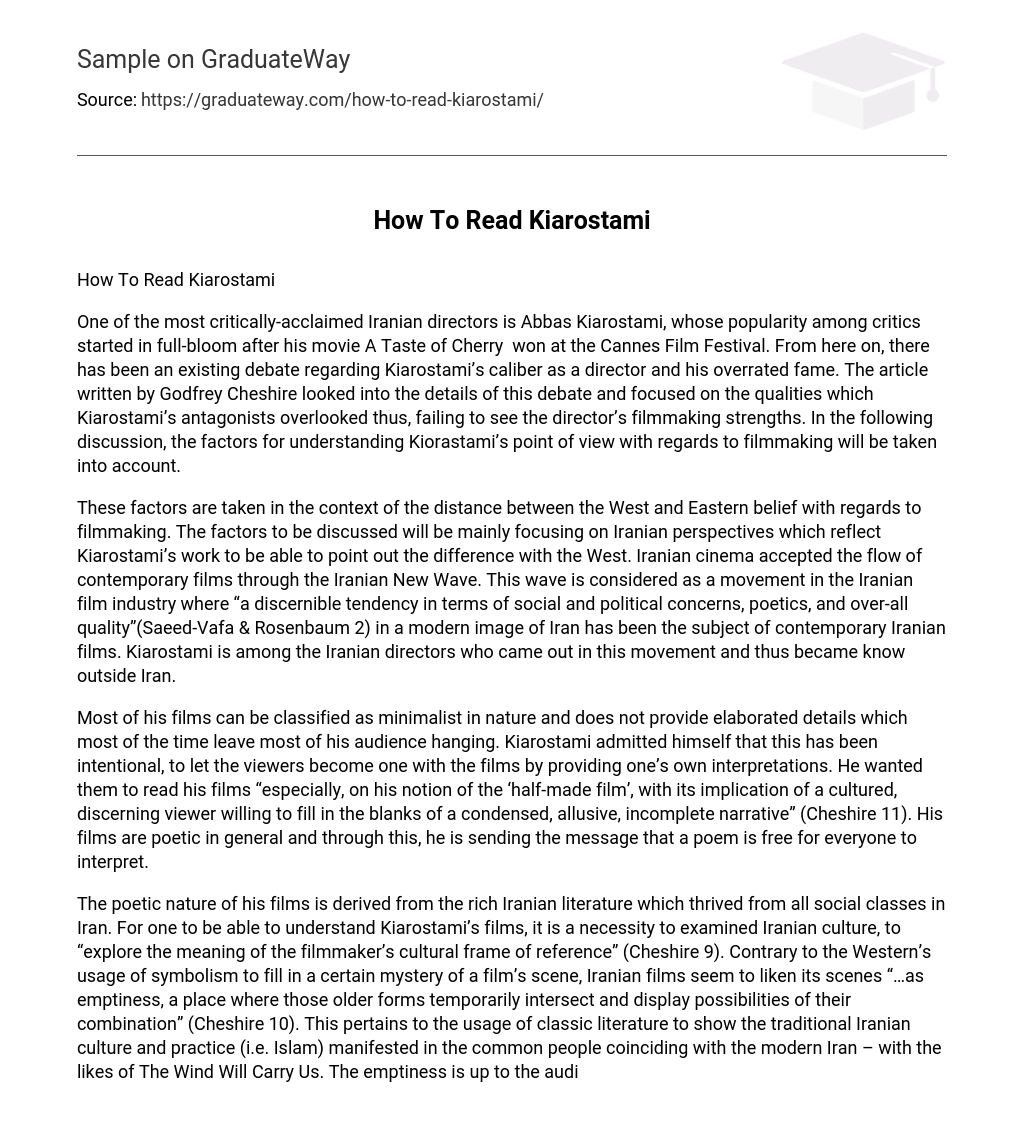One of the most critically-acclaimed Iranian directors is Abbas Kiarostami, whose popularity among critics started in full-bloom after his movie A Taste of Cherry won at the Cannes Film Festival. From here on, there has been an existing debate regarding Kiarostami’s caliber as a director and his overrated fame. The article written by Godfrey Cheshire looked into the details of this debate and focused on the qualities which Kiarostami’s antagonists overlooked thus, failing to see the director’s filmmaking strengths. In the following discussion, the factors for understanding Kiorastami’s point of view with regards to filmmaking will be taken into account.
These factors are taken in the context of the distance between the West and Eastern belief with regards to filmmaking. The factors to be discussed will be mainly focusing on Iranian perspectives which reflect Kiarostami’s work to be able to point out the difference with the West. Iranian cinema accepted the flow of contemporary films through the Iranian New Wave. This wave is considered as a movement in the Iranian film industry where “a discernible tendency in terms of social and political concerns, poetics, and over-all quality”(Saeed-Vafa & Rosenbaum 2) in a modern image of Iran has been the subject of contemporary Iranian films. Kiarostami is among the Iranian directors who came out in this movement and thus became know outside Iran.
Most of his films can be classified as minimalist in nature and does not provide elaborated details which most of the time leave most of his audience hanging. Kiarostami admitted himself that this has been intentional, to let the viewers become one with the films by providing one’s own interpretations. He wanted them to read his films “especially, on his notion of the ‘half-made film’, with its implication of a cultured, discerning viewer willing to fill in the blanks of a condensed, allusive, incomplete narrative” (Cheshire 11). His films are poetic in general and through this, he is sending the message that a poem is free for everyone to interpret.
The poetic nature of his films is derived from the rich Iranian literature which thrived from all social classes in Iran. For one to be able to understand Kiarostami’s films, it is a necessity to examined Iranian culture, to “explore the meaning of the filmmaker’s cultural frame of reference” (Cheshire 9). Contrary to the Western’s usage of symbolism to fill in a certain mystery of a film’s scene, Iranian films seem to liken its scenes “…as emptiness, a place where those older forms temporarily intersect and display possibilities of their combination” (Cheshire 10). This pertains to the usage of classic literature to show the traditional Iranian culture and practice (i.e. Islam) manifested in the common people coinciding with the modern Iran – with the likes of The Wind Will Carry Us. The emptiness is up to the audience perception where one’s own imagination will take an active participation for the film to serve as a social activity, a mental discourse.
Iran, as one of the oldest Muslim country in the Arab peninsula, must be understood as well in looking at its values using religion. Kiarostami’s films aside from using Iranian poetry as a reference also manifest Shiite thought. Cheshire specifically cited one though regarding the concept of “zahir (the outward, the apparent) and the batin (the inner, the hidden, the esoteric meaning)” (Cheshire 14). This emphasizes of a “vertical return” points to the East’ “original and hidden idea” (Cheshire 14) which needs to be interpreted not just for mental exercise but as well as a spiritual participation. In the over-all characteristics attributed to Abbas Kiarostima’s works, the Iranian culture reflects its high-regard for the development of prolific wisdom through films by means of engaging in imaginative interpretation. Iranian cinema is not merely a leisure activity; it is a mind-enriching social movement which encompasses Iranian culture in the films at its finest.
Works Cited
Saeed-Vafa, Mehrnaz. Abbas Kiarostami. USA: University of Illinois Press, 2003.
Cheshire, Godfrey. “How to Read Kiarostami.” Cineaste 25 4 (2000): 8-15.





